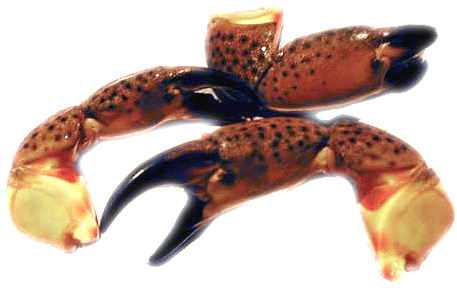|
|
|
|
A member of the Mud Crab Family these crabs are found from North Carolina to Texas with the greatest concentration and size found in southern Florida and the Keys. Adult stone crab are easily recognized by their oval body and two large claws. The adult body of the stone crab is dark brownish red, more or less mottled and spotted with dusky gray. An interesting feature about the stone crab is the mark on the inside of the large stone crab claws that resembles a thumb print.
Stone Crabs are not adept swimmers so like other members of the mud crab family they burrow deep hole in the sand or mud or live under rocks and mangrove roots. Almost all the edible meat in in the claw so commercial trappers twist the main claw off and throw the crab back into the sea to regenerate another claw which takes about 18 months. These are called retreads but the next claw will never reach the size of the first. The stone crab can regenerate its claws three to four times. Fishery regulations specify a harvest season of October 16 to May 14. Florida law forbids the taking of whole stone crabs. Fishermen are allowed to take claws at least 2 3/4 inches long and are required to return stone crabs safely to the water. Stone crab claws must be cooked or flash cooked prior to freezing or the meat will not separate from the shell when thawed and cooked from a green state. Stone Crabs are generally eaten like lobster with little embellishment like melted butter of a very light sauce.
|
|
|
|
|

